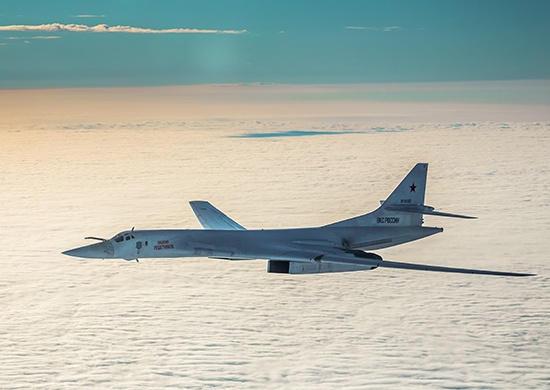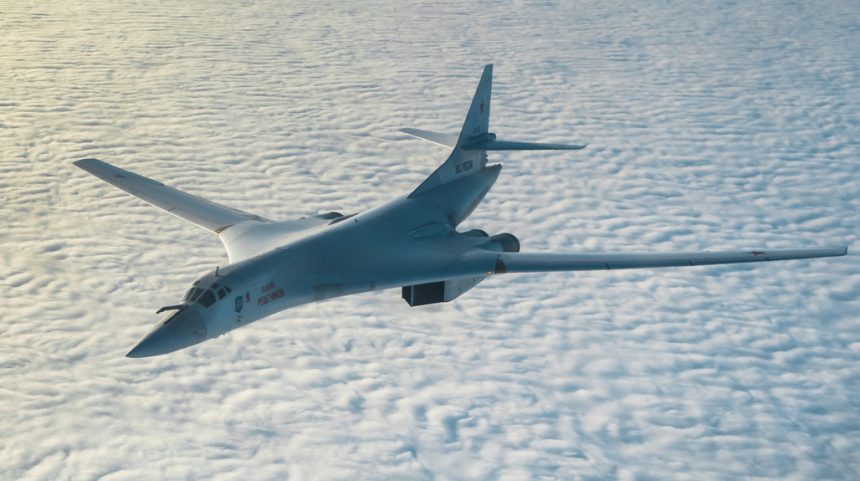Two Tu-160 Blackjack strategic missile carriers performed a mission over the neutral waters of the Barents, Greenland and Norwegian seas, a region where U.S. B-1 Lancer bombers are going to operate in a couple of weeks, reaffirming the strategic value of the Arctic area and Scandinavia.
Russian Tu-160 Blackjack bombers have carried out a 12-hour planned mission over the Barents, Greenland and Norwegian seas, the Press service of Russian Ministry of Defense announced in a public statement.
The mission took place in international airspace, over neutral waters “in strict accordance with the International Rules for the Use of Airspace” and the bombers were also escorted by MiG-31s of the Northern Fleet naval aviation.
The Tu-160 Blackjacks took off from Engels airbase, in southwestern Russia, and headed north to reach the Barents Sea from the Kola Peninsula before the route continued further north and west over the Norwegian Sea. Then, according to the reports, the bombers flew west, more or less towards Iceland, then again northeast off Greenland before heading north of Svalbard, across Franz Josef Land towards Novaya Zemlya then over the Kara Sea en route south.
Два стратегических ракетоносца Ту-160 ( борт RF-94111, позывной 28851 и борт RF-94112, позывной 28852) выполнили плановый полет в воздушном пространстве над нейтральными водами акваторий Баренцева, Гренландского и Норвежского морей. #bearnet #RuAF pic.twitter.com/uGtoZzrVaI
— Записки охотника (@galandecZP) February 9, 2021
The Tupolev Tu-160 Blackjack, also known as the “White Swan”, is a noteworthy aircraft because of its size, speed and rarity. The Tu-160 took part in the Air War in the skies over Syria; at least one Tu-160 aircraft flew a strike mission on Nov. 17, 2015 that hit ISIL targets in Syria using Russian 3M-54 Kalibur cruise missiles launched at standoff range.
While the U.S. cancelled its ambitious XB-70 Valkyrie super bomber program in 1969 and later developed the B-1 and low-observable B-2 along with the upcoming B-21 Raider, Russia has begun a program of updating avionics, engines and weapons systems on the Tu-160 and started production of the upgraded bombers again. The new Tu-160M2s are not be rebuilt, upgraded existing Tu-160s, but rather new production aircraft coming from the Tupolev plant. The new Tu-160M2 version, includes a glass cockpit, weapons upgrades, new engines and the removal of obsolete equipment no longer relevant to the Tu-160’s mission. The original Tupolev Tu-160 “Blackjack” first flew in 1981 and entered service in 1987. The first flight of the first Tu-160M2 took place on Feb. 2, 2020 and lasted 2 hours and 34 minutes.
While Tu-160 and Tu-95 bombers fly long-range over the neutral waters of the Arctic, North Atlantic, Black and Baltic Seas, and the Pacific Ocean, it’s worth noticing that the latest mission of the Blackjacks comes just a few days before four B-1B Lancer bombers deploy to Orland Air Force Station for the first ever deployment to Norway.
Russia sends two Tu-160 nuclear-capable bombers on 12-hour flight over Barents, Greenland and Norwegian seas. https://t.co/jCyMDlho1v
The flight coincides with US preparting to deploy four (non-nuclear!) B-1 bombers to Norway for the first time. https://t.co/ss9SohrJmo pic.twitter.com/pZxukOdvFf
— Hans Kristensen (@nukestrat) February 9, 2021
In fact, as already reported, for the first time, an expeditionary B-1 Lancer bomber squadron from Dyess AFB, will deploy to Ørland Air Force Station, in central Norway, as part of an upcoming BTF (Bomber Task Force) mission.
“While details of specific missions or numbers of events are not discussed as part of routine operational security standards, U.S. Air Forces in Europe routinely host a variety of U.S. aircraft and units across the theater in support of USEUCOM objectives,” said the official release on the EUCOM website dated Feb. 2, 2021.
This is what this Author wrote about the upcoming deployment (expected between Feb. 20 and 21, 2021, according to Scramble Magazine):
Noteworthy, B-1s have already operated in the region last year, although as part of long-range round-trip missions from CONUS (Continental US) bases: on May 20, 2020, two B-1B Lancers from the 28th Bomb Wing, Ellsworth Air Force Base, South Dakota, conducted a mission to the Nordic region. The mission, one in a series of long-range strategic Bomber Task Force missions to Europe, was worth of note for at least a couple of interesting details: first, it marked the first time B-1s flew over Sweden to integrate with Swedish Gripens while conducting close-air support training with Swedish Joint Terminal Attack Controller ground teams at Vidsel Range; second, the B-1s integrated with Royal Norwegian Air Force F-35s to fly tactical sorties and conduct a low-approach over Ørland Air Station, Norway, the home of the RoNAF’s recently operational F-35 fleet.
[…]
From there [Orland], the BONEs (as the B-1s are dubbed by their aircrews) will probably launch sorties over the Arctic Circle a region whose strategic importance and value were reaffirmed with the “extended duration mission” flown there also by the B-2 Spirit stealth bombers deployed to RAF Fairford, UK, in 2019 and 2020.










